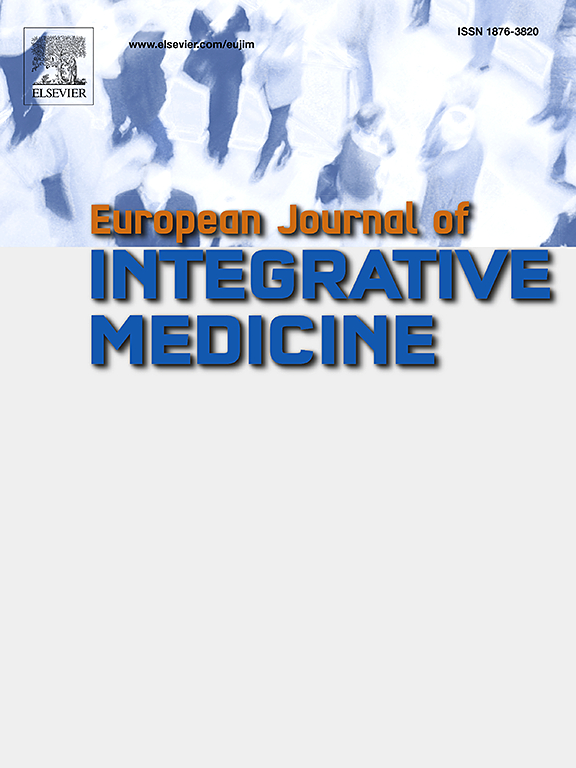Revealing the anti-inflammatory mechanism and effective constituents of Hosta plantaginea flowers by a strategy integrating network pharmacology, molecular docking, and experimental verification
IF 1.9
4区 医学
Q3 INTEGRATIVE & COMPLEMENTARY MEDICINE
引用次数: 0
Abstract
Introduction
Inflammation is a common cause of illness among outpatients, but effective drugs are extremely scarce. Hosta plantaginea flower is an important herbal medicine in China that treats inflammation-related diseases, but its anti-inflammatory mechanism remains unclear.
Methods
Systematic network pharmacology was employed to decipher H. plantaginea flower's anti-inflammatory hub targets and candidate phytochemicals. Furthermore, molecular docking was used to elucidate the interaction of constituents and targets. Afterward, the anti-inflammatory activity of H. plantaginea flower and its mechanism were validated in RAW264.7 cells activated by lipopolysaccharide (LPS).
Results
H. plantaginea flower contains 153 phytochemicals, of which 85 were potential effective constituents. 949 H. plantaginea flower targets and 814 inflammation-related targets were predicted, of which 211 intersecting targets were acquired. Six major constituents, including corvitin, phytyldiol, agapanthagenin, 5,7-dimethoxy-8-methyl-4′-hydroxyflavan, (3R)-2,3-dihydro-7-hydroxy-3-[(4-methoxyphenyl)methyl]-4H-1-benzopyran-4-one, and phenol, 4-[(2S)-3,4-dihydro-5,7-dimethoxy-2H-1-benzopyran-2-yl] were picked out. Furthermore, 6 hub targets such as C-type lectin-like receptor 2 (CLEC1B), toll-like receptor (TLR), tumor necrosis factor (TNF), recombinant V-Rel reticuloendotheliosis viral oncogene homolog A (RELA), signal transducer and activator of transcription 3 (STAT3), and protein kinase B α (AKT1) were obtained using Gene Ontology and Kyoto Encyclopedia of Genes and Genomes functional analyses. Molecular docking indicated that these 6 constituents had strong binding abilities with these 6 hub targets. Finally, the anti-inflammatory effect of H. plantaginea flower and its mechanism were verified in LPS-induced RAW264.7 cells by the inhibition of CLEC1B, TLR-4, TNF-α, STAT3, and Akt1 proteins, thereby suppressing the overproduction of nitric oxide.
Conclusion
H. plantaginea flower exerted a significant anti-inflammatory activity by suppressing TLR-4 and CLEC1B signaling pathways, which was elucidated and validated by an integrated strategy based on network pharmacology, molecular docking, and experimental verification. Collectively, this study provides a novel insight into the pharmacodynamics and mechanisms of H. plantaginea flower as a promising agent in treating inflammation-related disease.
通过网络药理学、分子对接和实验验证相结合的策略,揭示玉簪花的抗炎机理和有效成分
引言炎症是门诊病人的常见病因,但有效药物却极为缺乏。方法采用系统网络药理学方法破译了玉簪花的抗炎枢纽靶点和候选植物化学成分。此外,还采用分子对接法阐明了成分与靶点之间的相互作用。随后,在脂多糖(LPS)激活的 RAW264.7 细胞中验证了车前草花的抗炎活性及其机制。预测了 949 个车前草花靶标和 814 个炎症相关靶标,其中获得了 211 个交叉靶标。六种主要成分,包括柯维丁、phytyldiol、agapanthagenin、5,7-二甲氧基-8-甲基-4′-羟基黄烷、(3R)-2、(3R)-2,3-二氢-7-羟基-3-[(4-甲氧基苯基)甲基]-4H-1-苯并吡喃-4-酮,以及苯酚,4-[(2S)-3,4-二氢-5,7-二甲氧基-2H-1-苯并吡喃-2-基]。此外,通过基因本体论和《京都基因和基因组百科全书》的功能分析,还获得了 6 个枢纽靶标,如 C 型凝集素样受体 2(CLEC1B)、收费样受体(TLR)、肿瘤坏死因子(TNF)、重组 V-Rel 网状内皮病病毒癌基因同源物 A(RELA)、信号转导和激活转录 3(STAT3)以及蛋白激酶 B α(AKT1)。分子对接表明,这 6 种成分与这 6 个枢纽靶点有很强的结合能力。最后,在 LPS 诱导的 RAW264.7 细胞中,通过抑制 CLEC1B、TLR-4、TNF-α、STAT3 和 Akt1 蛋白,从而抑制一氧化氮的过度产生,验证了车前草花的抗炎作用及其机制。通过基于网络药理学、分子对接和实验验证的综合策略,阐明并验证了车前草花通过抑制 TLR-4 和 CLEC1B 信号通路发挥显著的抗炎活性。总之,这项研究为了解车前草花的药效学和机制提供了新的视角,使其成为治疗炎症相关疾病的一种有前途的药物。
本文章由计算机程序翻译,如有差异,请以英文原文为准。
求助全文
约1分钟内获得全文
求助全文
来源期刊

European Journal of Integrative Medicine
INTEGRATIVE & COMPLEMENTARY MEDICINE-
CiteScore
4.70
自引率
4.00%
发文量
102
审稿时长
33 days
期刊介绍:
The European Journal of Integrative Medicine (EuJIM) considers manuscripts from a wide range of complementary and integrative health care disciplines, with a particular focus on whole systems approaches, public health, self management and traditional medical systems. The journal strives to connect conventional medicine and evidence based complementary medicine. We encourage submissions reporting research with relevance for integrative clinical practice and interprofessional education.
EuJIM aims to be of interest to both conventional and integrative audiences, including healthcare practitioners, researchers, health care organisations, educationalists, and all those who seek objective and critical information on integrative medicine. To achieve this aim EuJIM provides an innovative international and interdisciplinary platform linking researchers and clinicians.
The journal focuses primarily on original research articles including systematic reviews, randomized controlled trials, other clinical studies, qualitative, observational and epidemiological studies. In addition we welcome short reviews, opinion articles and contributions relating to health services and policy, health economics and psychology.
 求助内容:
求助内容: 应助结果提醒方式:
应助结果提醒方式:


